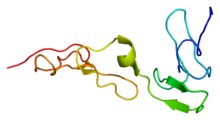
Back عوز البروتين إس Arabic Nedostatak proteina S BS Protein-S-Mangel German Déficit en protéine S French Deficit di proteina S Italian
| Protein S deficiency | |
|---|---|
 | |
| Protein S structure | |
| Specialty | Hematology |
| Symptoms | Purpura fulminans[1] |
| Causes | Vitamin K deficiency[1] |
| Diagnostic method | Coagulation test[1] |
| Treatment | Heparin, Warfarin[2] |
Protein S deficiency is a disorder associated with increased risk of venous thrombosis.[1] Protein S, a vitamin K-dependent physiological anticoagulant, acts as a nonenzymatic cofactor to activate protein C in the degradation of factor Va and factor VIIIa.[3]
Decreased (antigen) levels or impaired function of protein S leads to decreased degradation of factor Va and factor VIIIa and an increased propensity to venous thrombosis. Some risk factors for deep vein thrombosis or pulmonary embolism in patients with protein S deficiency include pregnancy, older age, hormonal therapy, consumption of birth control pills, recent surgery, trauma, and physical inactivity.[4] Protein S circulates in human plasma in two forms: approximately 60 percent is bound to complement component C4b β-chain while the remaining 40 percent is free, only free protein S has activated protein C cofactor activity[medical citation needed]
- ^ a b c d "Protein S Deficiency. Learn about Protein S Deficiency | Patient". Patient. Retrieved 2016-10-16.
- ^ Cite error: The named reference
emedwas invoked but never defined (see the help page). - ^ "Protein S: Reference Range, Collection and Panels, Interpretation". 2016-06-01.
{{cite journal}}: Cite journal requires|journal=(help) - ^ "Protein S Deficiency". Cleveland Clinic. Retrieved 7 February 2023.